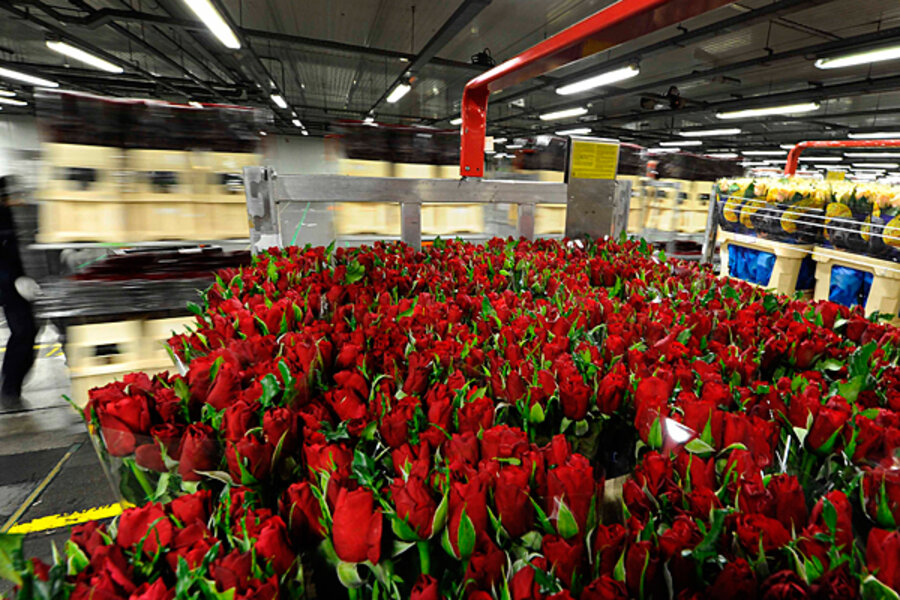Is it possible to be a cheapskate on Valentine's Day (and live)?
Loading...
| Mexico City
Yet another holiday approaches, and so too another demand on the wallet. In these tough economic times, the pressures are so high that American talk shows are even inviting experts on to discuss inexpensive ways to show your partner you love them this Valentine’s Day.
But, men the world over, have no fears. Most women, from Britain to Beijing, are saying that all they really want is something symbolic that shows how much you care.
A study by the British dance event Move It, which asked 500 men and women about their attitudes toward romance, found that what women would most like to hear is: “Would you like to dance?”
Another poll circulating in the British press called the Lindt Lindor “Code of Modern Chivalry” report showed that 78 percent of women surveyed would most treasure a love letter or poem.
And in China, where Valentine’s Day became popular with young Chinese about 10 years ago, displacing a traditional Chinese version on July 7 that had never been very widely celebrated, one poll asking about favorite Valentine’s Day gifts showed that 59.1 percent said “the love that comes with the gift is the most important.” (Of course, while11.3 percent said some sort of handmade gift is their favorite, an equal 11 percent reported a preference for diamond jewelry.)
Have we all the sudden become hopeless romantics? Jennifer Hughes, an assistant professor of religious studies at the University of California, Riverside, says there might be some external factors at play. “Difficult economic times change the meaning of romance,” she says. Gestures might take on more meaning when the ability to buy “things” is diminished.
Alarm bells
For some men that might set off alarm bells. The Move It study showed that women would rather date a bad kisser who can dance, rather than vice versa – no small pressure for the less rhythmically inclined, while the Lindt study showed that only half of men have even attempted to pen a love poem or letter.
Yet there are still reasons to resist the pressures that abound this weekend. A Reuters/Ipsos poll, which contacted men and women in 23 countries, showed that a good percentage of both sexes said that they’d actually just rather spend the day with their pet.
That means that men in Turkey, where 49 percent would rather hang out with their dog (or cat or fish), followed by India (41 percent), Japan (30 percent), and China (29 percent) should be able to get away with a fairly low investment this Sunday.
And even in France, which scored the highest in romance in the poll (only 10 percent of them would prefer their pet), the desire for something simple abounds. One French woman in the 16th district of Paris says her husband’s Valentine habits track all over the map. “Take me to a restaurant; je suis très contente,” she says.
Although the biggest Valentine’s Day news in France is the reported gift by Angelina Jolie of a 200-year old olive tree for Brad Pitt, to grace their $50 million Chateau Miraval home in Provence, our correspondent’s informal survey shows that perfume is the most marketed option. Purchasing simple cakes and tarts that couples plan to share together is also popular.
A US export - but we love it
In many countries, Valentine’s Day is seen as an American export, and one to begrudge. But some countries still have a romantic notion of Feb. 14. In Canada, a study by MasterCard Canada showed that the great majority of men and women (81 percent of men and 93 percent of women) give gifts because they want to, not because they feel that they have to.
A Zogby study shows that men (31 percent) are more likely than women (18 percent) to spend more than $50 this Sunday – which is not surprising given the marketing of Valentine’s Day as a “woman’s day.” “Valentine’s Day is very gendered in the sense that it is the man that gives the woman gifts. The man is to be the provider, the woman the recipient,” says Ms. Hughes.
But even there, change is under way. A survey by the dating website chemistry.com showed that 55 percent of men want to hear “I love you” on Valentine’s Day vs. 45 percent of women. And even in macho Mexico, a survey by the consumer industry watchdog showed that it is actually the nation’s men who care more about the holiday. Fifty-two percent of women plan to celebrate Sunday, versus 65 percent of men. But here women do want gifts, not just displays of love: chocolate, flowers, or some other detail.
*Peter Ford in China and Robert Marquand in France shared their region’s cultural views for this piece.
_______________
For more on love and marriage, check out American attitudes toward fidelity.
Follow us on Twitter.





